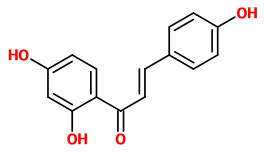Glycyrrhiza inflata Batalin - Fabaceae - 胀果甘草 zhang guo gan cao (chin.), Chinese licorice, Xinjiang licorice
Perennial subshrub, 50-150 cm tall; native to riverbanks and wastelands in North China, Kazakhstan, Kyrgyzstan, Mongolia, Tajikistan, Turkmenistan, Uzbekistan. http://www.efloras.org/florataxon.aspx?flora_id=2&taxon_id=242323663
„Licorice root has been used as a traditional medicine for the treatment of gastric ulcer, bronchial asthma and inflammation. Licochalcone A is a major component of Xinjiang licorice, Glycyrrhiza inflata… findings suggest that the anti-inflammatory effect of Glycyrrhiza inflata is ascribable to the potent inhibition of NF-κB by Licochalcone A, Licochalcone B and Licochalcone D.“
[Glycyrrhiza inflata-derived chalcones, Licochalcone A, Licochalcone B and Licochalcone D, inhibit phosphorylation of NF-κB p65 in LPS signaling pathway., Furusawa, J.I., Funakoshi-Tago, M., Mashino, T., Tago, K., Inoue, H., Sonoda, Y., Kasahara, T., International immunopharmacology, 9(4), 2009, 499-507]
„In Chinese Pharmacopoeia, as Glycyrrhiza glabra and G. uralensis, it is listed as one of the sources of licorice… Extensive chemical studies revealed that G. inflata contained the same bioactive constituents as Glycyrrhiza glabra and G. uralensis, which possess a wide array of biological properties. Triterpenoids such as glycyrrhizin, glycyrrhetinic acid, apioglycyrrhizin, araboglycyrrhizin, and inflasaponins II, VI and flavonoids such as liquiritin and isoliquiritigenin are the major compounds.“
[HPLC analysis of glycyrrhizin and licochalcone a in Glycyrrhiza inflata from Xinjiang (China), Junbo Xie, Yanqing Zhang, Wenquan Wang, Chemistry of Natural Compounds, Vol.46(1), 2010, 148-151]
The chalcones licochalcone G, licochalcone A, echinantin, 5-prenylbutein, licochalcone D, isoliquiritigenin, licoagrochalcone A, and kanzonol C, were isolated as active principles from the acetone extract of Glycyrrhiza inflata. Two compounds without prenyl group (echinantin, isoliquiritigenin) showed strong inhibitory effects on various neuraminidases from influenza viral strains, H1N1, H9N2, novel H1N1 (WT), and oseltamivir-resistant novel H1N1 (H274Y) expressed in 293T cells. Echinantin (5μM) increased the efficacy of oseltamivir against H274Y neuraminidase.
[Chalcones as novel influenza A (H1N1) neuraminidase inhibitors from Glycyrrhiza inflata., Dao, T.T., Nguyen, P.H., Lee, H.S., Kim, E., Park, J., Lim, S.I., Oh, W.K., Bioorganic & medicinal chemistry letters, 21(1), 2011, 294-298]
Major components of the volatile oil of G.inflata roots are (E)-2-heptenal, 5-methyl furfural, o-guaiacol, 2-phenylethanol, (4E)-decenal, cumin aldehyde, (E)-anethol, indole, p-vinyl-guaiacol (10%), eugenol and methyl eugenol, γ-nonalactone, β-caryophyllen and its oxide. Special components are β-dihydro-ionone (7%) and 1,10-Epoxy-amorph-4-ene (12%).
[Volatiles Profiling in Medicinal Licorice Roots Using Steam Distillation and Solid‐Phase Microextraction (SPME) Coupled to Chemometrics. Farag, M. A., & Wessjohann, L. A. , Journal of food science, Vol.77(11), 2012, 1179-1184]

